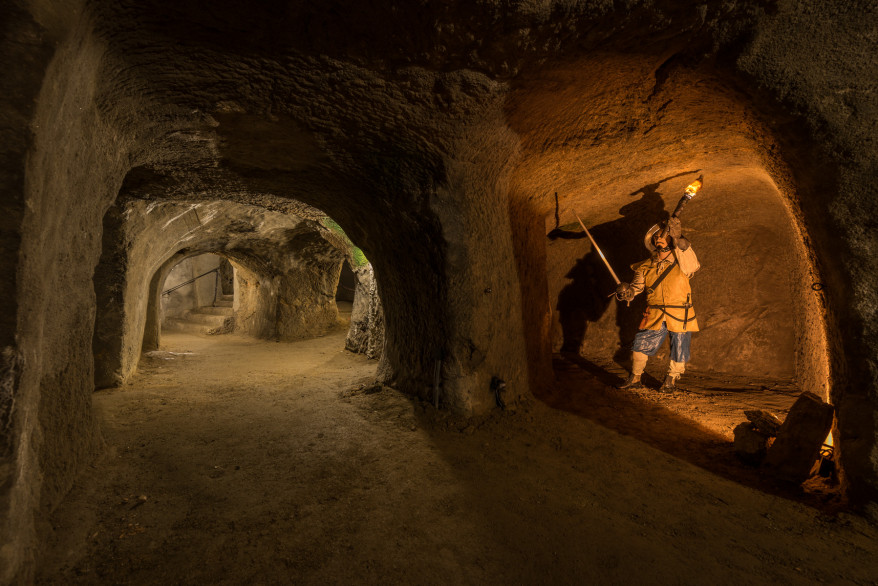The underground of Znojmo belongs among unique historical sights not only in the Czech Republic but also within Central Europe. It comprises a system of underground passageways and cellars that is almost 27 kilometres long, and has up to 4 storeys.
We suppose, based upon two inscriptions with years found in the underground that the beginning of the passageway, that the construction dates back to the turn of the 14th and the 15th centuries. Every one of the residential buildings had an underground space apparently serving economical purposes. Medieval Znojmo was a city rich both for its location that guaranteed a successful harvest of tasty wine and other agricultural products as well as for its location on an important trading road, and thus became a significant commercial centre. The underground passageways were in all aspects advantageous for the appropriate storing of goods.
The underground passageways were built and interconnected originally on an area of 35 to 40 hectares beneath the historical core of the city. Hired workers, labourers and the town's grooms took part in the construction; one of the discoveries also shows the participation of the miners of Jihlava, experts in mining works. Simple tools such as a cutter, a thresher, a tusk and means for removal of excavated matter were used. 50 to 55 thousand square meters of grown, solid and hard rock was extracted to build the underground passageways. We do not know exactly where the extracted material was used. We can just suppose that bigger pieces, solid and resistant, with a suitable shape were used for the completion, reconstructions and repairs of the extensive municipal fortifications.
Many speculative conclusions concerned the originally strategic and defensive purpose of these passageways. The passageways played the role of an important and inseparable part of the town's fortification system in the time when Znojmo held an exclusive position in a chain of frontier fortifications. It is remarkable that no plans of the passageways of Znojmo have been preserved either in the archive or in the municipal chronicle. That may be possibly explained by the fact that the town protected its defensive system well, and the plan of the passageways was (known) to a very close circle of persons in the municipal administration. The assumption that the passageways were used for the defence of the city in times of war is suggested also by its extraordinarily complicated and confused system in both horizontal and also vertical direction.
The underground water circulation system is also worth noting. The major part flows into the underground through springs in sediments and cracks in solid rocks. Water was contained in the underground in many wells and connected by a resourceful draining stole – so called Jesuit's water supply. The name is not derived from Jesuits actually directly physically participating in its construction. But it need be said that the construction of such a resourceful object that supplied Znojmo with drinking water also in hard times belongs to the highlights of the Jesuit order's influence in Znojmo. It is a system of a main conduit with adjacent branches reaching into various municipal parts of the medieval city in connection with wells, fountains and sumps, draining water from the surroundings of Mansberk on the north of the city. The construction of the water supply was even more difficult than other passages, as the route of the water supply was conducted further than a kilometre behind the city fortifications by a specially built passageway through soft sand rocks behind the city.
Another interesting point is an extensive double-nave hall under the former building of the town hall (the department store DYJE is built on the place today) covered by an arch from quarry stone between central pillars. Supposedly there was a medieval torture room with tomb cells on the lower floor.
By gradual clogging of the underground spaces, the underground water drainage system was damaged after World War II, especially in connection with removing the remnants of bombing. Its influence appeared in the beginning of the sixties when the state of repair of the municipal development and communications revealed many hazards. An extensive exploration and redevelopment of the underground of Znojmo was launched by the years 1963 and 1965. The construction of the commercial centre disrupted a part of the passages in use, and some of them were closed. Similarly many of the passages had already been walled up or filled in in historical times. All remedial construction work had to attempt to preserve the shapes and surfaces of the passageways as they originally were, as they constitute significant historical construction evidence of the medieval way of tunnel driving.
Today the catacombs serve first of all their visitors. An approximately one kilometre long passageway begins on the Chicken market /Slepičí trh/, and it terminates in Obroková street connecting the Upper square /Horní náměstí/ with the Masarykovo square.



